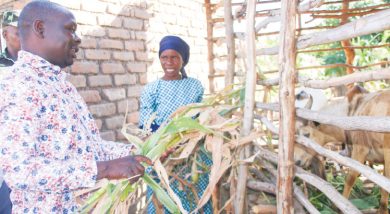Dwarf bananas, big bunches
As maize yield keeps dwindling due to erratic rains and degraded soils, farmers in Nkhata Bay are reverting to bananas to generate income for buying food and other basics.
Mpamba and Chikwina residents in the hilly shoreline districts have a long history of growing bananas, but yields keep falling due to frequent episodes of drought and widespread infestation of banana bunchy top disease.
Banana plantations across the country have been shrinking since the virus was discovered in Nkhotakota over a decade ago. The infestation has compelled farmers to uproot banana trees and replace them with disease-free seedlings. The government also distributes clean suckers to stop the crisis as the country currently imports truckloads of bananas from Tanzania and Mozambique.

However, some affected farmers in the interior of Traditional Authority Timbiri are turning to a dwarf banana variety, named William, to beat the devastating effects of climate change and disease.
“As the rainy season is mostly characterised by lengthy dry spells, William has proved resilient to drought. In dry conditions, this variety yields more than the taller varieties that we grew up growing in this area. Interestingly, it is resistant to the merciless disease wiping our out bananas,” says Chrissy Sisya, a member of Takondwa Club in Kamphomombo Village.
Sisya was speaking in the middle of a communal banana nursery comprising 155 planting stations. As the bananas multiply, interested farmers acquire suckers to plant in their upland fields, even to replace diseased plantations.
The banana-growing group has 12 members, including eight women. Sisya has 150 banana trees in her farm located on a raised ground.
“Many people grow bananas in valleys, but William thrives anywhere, even in highlands, since it can do with dry conditions,” she explains.
The woman sells bananas to generate income for supporting her family and saves some proceeds with a village banking group where she obtains low-interest business loans with ease.
“With bananas, you harvest all year round. If some food crops fail, we sell some bananas and buy food so that our families do not starve. Besides, the banking group helps us save some money in readiness for hardships caused by climate change,” she brags.
The newly introduced dwarf bananas in the cassava-growing village testify to the importance of the banana nursery where planting stations have tripled in two years.
Sisya’s club constantly passes on the suckers to interested farmers in a relay race sustained by the zeal to transform the hilly locality into a banana belt free from hunger and poverty despite weather shocks caused by climate change.
“We want new groups to benefit,” says James Mgoboza-Mhone, a model farmer who mentors his neighbours to reap bumper yields with the changing climate.
Apart from putting money in farmers’ pockets, Mhone says, bananas also help control the loss of topsoil in crop fields. The United Nations (UN) Food and Agriculture Organisations (FAO) reports that in the country, a crop field the size of a football ground loses up to 29 tonnes of soil a year.
The loss of fertile soils is worsening hunger and poverty. Farmers scarcely get bumper harvests in their breached fields gullied by water running off the ground. This makes livelihoods fragile as climate change bites harder,” says the lead farmer.
The banana farmers got the initial seedlings from agriculturalists at Mpamba Extension Planning Area in Nkhata Bay. This is part of the Adapt Plan project supported by the UN Development Programme (UNDP) and Global Environment Facility (GEF) to make people in the Least Developed Countries resilient to climate change.
The Department of Environmental Affairs in the Ministry of Natural Resources, Energy and Mining rolled out the initiative in Nkhata Bay, Ntcheu and Zomba in 2015.
“The livelihood of many people in Malawi heavily hinges on rain-fed agriculture, which is vulnerable to the adverse impacts of climate change. Currently, erratic rains, prolonged dry spells, seasonal droughts and floods pose a serious risk to farmers livelihoods. Adapt Plan aims at building resilient communities and minimise disruptions from climate disasters that affect everyday life and the local economy,” says Gullivert Gomani, from the EAD.
Apart from scaling bananas resistant to drought and the prevailing disease, other interventions include forest management, bakery, tailoring, irrigation farming, fish ponds and solar-powered integrated water supply schemes.
“As the effects of climate change become more pronounced, we cannot continue doing business as usual. We need to adjust accordingly. Adapt is here to empower rural communities to reduce their vulnerability to effects of climate change,” says Owen Chikoti, Nkhata Bay district environmental officer.
The Adapt Plan desk officer says the district is home to six irrigation schemes, 15 fish ponds, 20 banana multiplication groups, 19 goat-keeping groups and one tailoring group.
However, Sisya credits the dwarf bananas for lifting her out of poverty and chronic hunger. “At present, I’ve saved about K250 000 with the village bank and I intend to build a decent house for my family. Meanwhile, I pay fees for my son who is in secondary school.”





